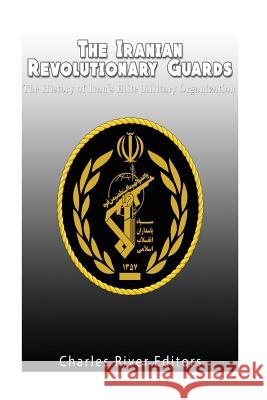The Iranian Revolutionary Guards: The History of Iran's Elite Military Organization » książka
The Iranian Revolutionary Guards: The History of Iran's Elite Military Organization
ISBN-13: 9781542324168 / Angielski / Miękka / 2017 / 68 str.
The Iranian Revolutionary Guards: The History of Iran's Elite Military Organization
ISBN-13: 9781542324168 / Angielski / Miękka / 2017 / 68 str.
(netto: 44,73 VAT: 5%)
Najniższa cena z 30 dni: 43,92 zł
ok. 13-18 dni roboczych
Dostawa przed świętami

Darmowa dostawa!
*Includes pictures *Includes online resources and a bibliography In early November 2016, Salar Abnoush, a leader in the Iranian Revolutionary Guard Corps (IRGC), stated that the IRGC "will be in the U.S. and Europe very soon." This quote came just before the U.S. presidential election, a time when President Barack Obama was winding down his presidency and American society was busy reflecting on his past actions over the 8 years of his presidency. Of those actions that incoming President Donald Trump has decided to focus on, "tearing up" the Joint Comprehensive Plan of Action (also more commonly known as the Iran Nuclear Deal) was near the top of the list. The crux of the deal focuses on Iran's agreement to rolling back uranium stockpiles and enrichment capabilities in exchange for the ending of nuclear-related sanctions against Iran. Due to the IRGC's current involvement in the Iranian economy, they stand to gain from the ending of the sanctions. Possible threats to the deal by the incoming Trump Administration are of concern in Iran, and the threat of the IRGC spreading in Western countries is a concern as well. The impact of the changing of terms to the Iran Nuclear Deal is just one concern among many of members of the IRGC. The multi-party conflict of the Syrian Civil War has pulled Iran deeper into this global conflict, as the number of refugees and internally displaced people rise. Through it all, the Iranian Revolutionary Guard Corps has held a position of power and prestige in Iranian society and has inspired both revolution and concern around the world. The IRGC is notable for its involvement in conflicts around the Middle East, particularly in supporting Shi'a groups through military training and finance, as well as backup support on the battlefield. This is not to say the IRGC enters into conflicts for the sake of being involved, but rather, they see these particular situations as serving the interests of Iran and furthering their brand of Shi'ism, a sect of Islam. The IRGC sees itself as a protector of Islam, Iran's theocracy, and the principles of the 1979 Iranian Revolution, so its involvement is always framed in terms of benefits to the overall goals of promoting revolutionary ideals. As analyst Afshon Ostovar puts it, "The IRGC is a multifaceted organization with reach into many different areas. It is a security service, an intelligence operation, a social and cultural force, and a complex industrial economic conglomerate." The IRGC operates in a very similar manner to other Islamist paramilitary organizations, such as Hezbollah, Hamas, the Muslim Brotherhood, and--their current enemies on the battlefield--the Islamic State of Iraq and the Levant (ISIL) and Jabhat Al-Nusra. These Islamist groups' power and influence comes from their control over the societies in which they operate and whether or not they have influential allies. The main difference for the IRGC, however, is the support of Iranian leadership in carrying out their main mission of maintaining and exporting the revolution. In essence, the IRGC has rooted itself in Iranian society and spread its influence through association with the society's most integral components--the education system, businesses, civil organizations, and religion--all at the request and blessing of the Supreme Leader of Iran. This is a similar model ISIL and Jabhat Al-Nusra are attempting to carry out in Syria and Iraq, and the one that Hamas and Hezbollah currently carry out in Lebanon and the Palestinian territories. The IRGC is also very much involved in Iran's economy and has a stake in its nuclear ambitions.











